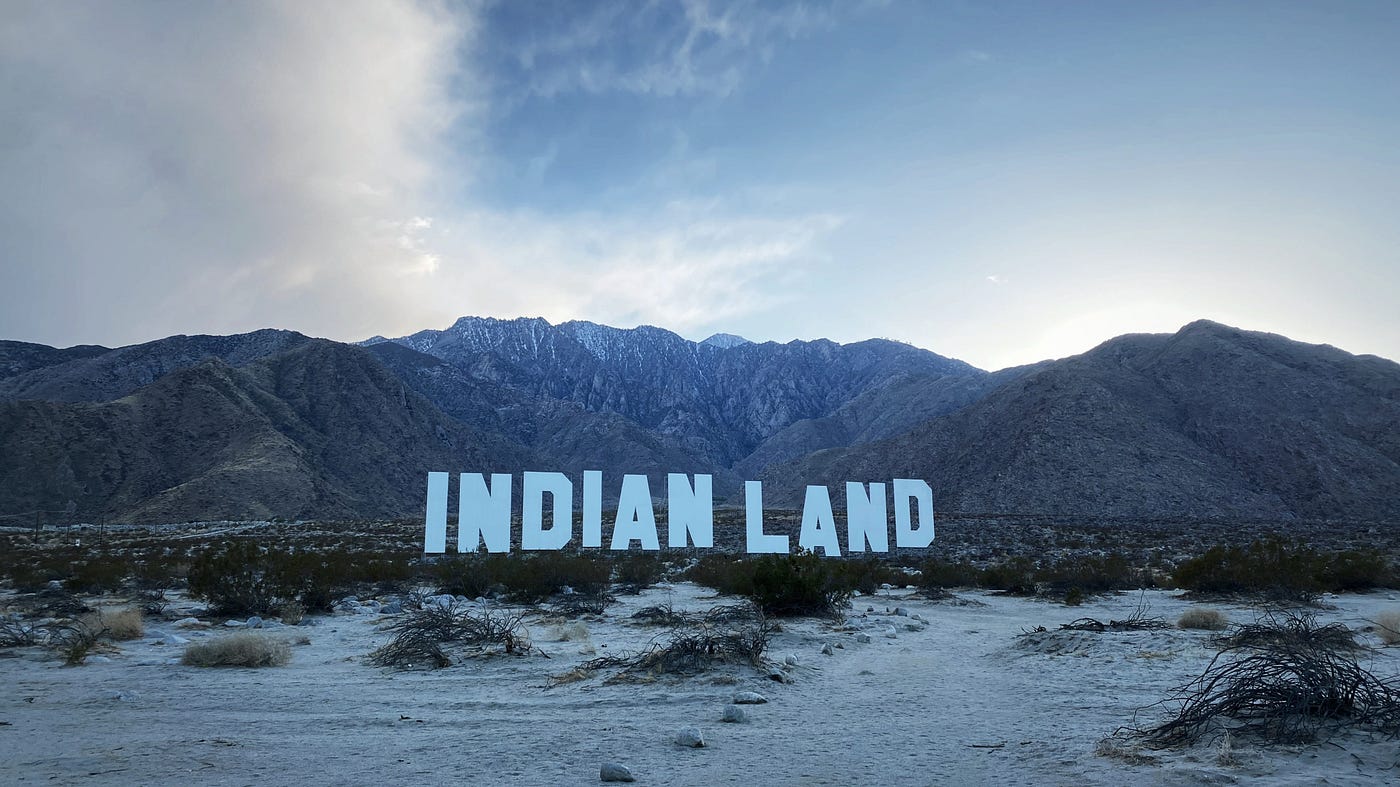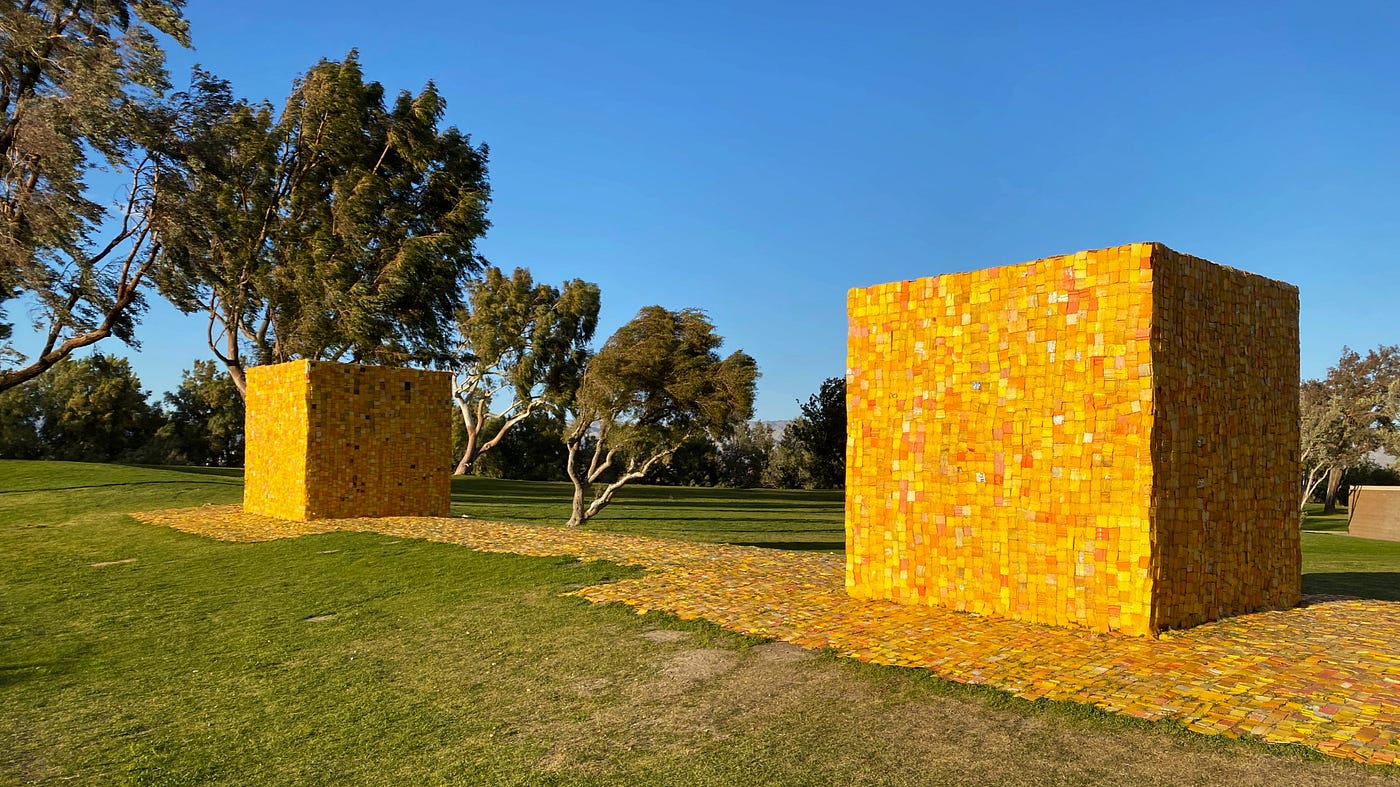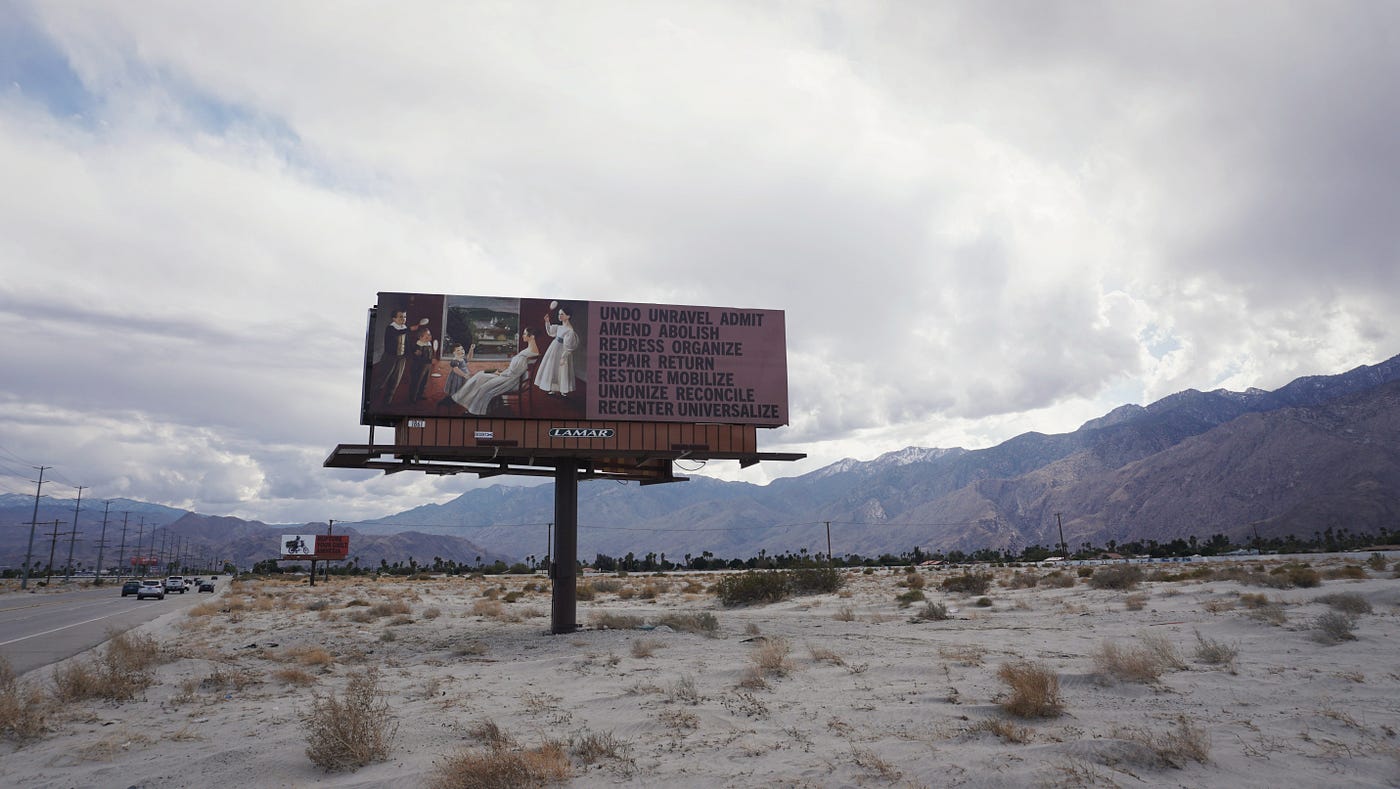
I’ve been to the desert before.
In 2017 and 2019, I headed to Palm Springs, California, for the first two Desert X biennials. I set out again in March of 2021. This time was different. In the past, I was mesmerized and transported. Now, I felt frustrated and was left wanting. A mantra developed, an inner voice grew louder: What happened? What went wrong?
Let’s start at the beginning.
A mirage appeared in the distance. Mirage was a very real, ranch-style cabin by American artist Doug Aitken. Its exterior and interior were covered in mirrored panels, creating camouflagic and kaleidoscopic effects. The exterior reflected the landscape and its opaline light; the interior reflected the faces of those who trekked to Coachella Valley for a new kind of contemporary art exhibit.
Mirage was part of Desert X 2017, an outdoor exhibition offering audiences a distinct context in which to engage with art: a cultural playground unyoked from institutionalized experiences within traditional museums and galleries. The 16 site-specific installations featured both American and international artists. These works were integrated into the desert environment and served as “a visual response to issues of vast importance to today’s global citizenry,” as stated by Desert X.
In its inaugural year Desert X presented pieces by artists “whose projects amplified and articulated global and local issues that ranged from climate change to starry skies, from tribal culture and immigration to tourism, gaming, and golf.” The nine-week event was free and open to the public, spanned 45 miles, and drew more than 200,000 visitors, vastly surpassing attendance expectations.
In 2019, the biennial grew to a roster of 18 artists, a footprint of 55 miles, and doubled its attendance to 400,000 visitors. Works such as John Gerrard’s Western Flag adopted a mesmerizing, eerie presence in the desert. The LED-illuminated monolith stood as both warning and admonishment. An animation of black smoke undulated on its massive screen. The smoke was in the shape of a wind-whipped flag and dispersed from the “Lucas Gusher,” the world’s first major oil find and long since exhausted of its fossil fuel. Spectators were confronted with the consequences of “flying the flag of [their] own self-destruction.”
Additional standout works that year included Sterling Ruby’s otherworldly SPECTER, a giant neon vessel appearing in the desert as a cognitive aberration; and Nancy Baker Cahill’s augmented reality piece Margin of Error, which swarmed over the now-toxic Salton Sea, a digital manifestation of humankind’s contributions to environmental disaster.
Then came Desert X AlUla.
Located in the Medina Region in northwestern Saudi Arabia, AlUla is an ancient oasis replete with geological, geographical, and historical significance. It has been described as “an open-air museum the size of a country.” Now AlUla represents, in part, the Saudi government’s recent plan to diversify Saudi Arabia’s economy by positioning it as a modern, international tourist destination. Only in 2019 did Saudi Arabia begin issuing tourist visas for the first time; AlUla opened in phases beginning in 2020.
Desert X AlUla (DX AlUla) was funded entirely by the Saudi government and took place over five weeks in early 2020 with an attendance of 9,000 visitors. Presented as a “plurality of voices,” the exhibit included 14 artists, 11 of which were from Saudi Arabia or the surrounding region. Five were female artists. Installation photos were indeed remarkable. Fused into the terrain, modern artworks contrasted with AlUla’s immemorial cliffs. Works were smeared across the landscape; others seemed to surface from the dunes.
The exhibit also inspired protests: After the Saudi partnership was announced, three of Desert X’s 14 board members resigned, citing Saudi human rights abuses and the government-sanctioned murder of Saudi journalist Jamal Khashoggi (Saudi Arabia is currently ranked as the seventh worst of 195 countries in Freedom House’s annual report). Art historian and curator Yael Lipschutz and American pop artist Ed Ruscha were outspoken in their criticisms. Christopher Knight, the Los Angeles Times art critic, called the Saudi exhibition “morally corrupt.”
In response, Desert X founder and board president Susan Davis defended the Saudi alliance to the Los Angeles Times as an “opportunity to generate ‘a new dialogue, one that reaches across boundaries and borders.’” A type of verbal tennis ensued. Even participating Desert X staff, curators, artists, and external supporters clashed over the exhibition’s objectives, methodology, and ethics; none were fully in alignment about the relationship between art and politics.
This disconnect emphasized the nuances of such a complex situation: How has art been leveraged as a driver of cultural and political change, both successfully and unsuccessfully, and what can be learned from that?
Historians could point out that we’ve been here before. In the late 1970s, when the Chinese government opened up its country to foreign business, the West approached the shift with a similar mindset, positing that investment would encourage a democratic portal for cultural and societal change. Decades later the opposite has proven to be true. A robust list of former oppressive rulers all leveraged art and their support of art institutions as propaganda vehicles, to varying degrees of success.
Desert X presented the satellite exhibition in AlUla as a progressive catalyst, a vehicle to support artists in the Middle East and champion art above all else. And yet it did so in a place where freedom of expression is repressed. Some proponents argue that’s exactly the point: to produce and exhibit art in a place that has previously decried it. But within the AlUla partnership, can the mission of Desert X truly be segregated from the violent reality of the Saudi theocracy? The two seem utterly interwoven and at odds with one another — or are they?
With DX AlUla, Desert X president Susan Davis endeavored to “welcome a multiplicity of voices,” but it’s unclear if that welcome is truly extended to Desert X supporters. Saudi women have long suffered from systemic discrimination, oppression, and violence, and homosexuality is criminalized in Saudi Arabia. Palm Springs, Desert X’s host city in the U.S., has been an LGBTQ haven for decades. There’s a dissonance when Desert X asks audiences to pay attention to the emotional, historical, and social layers of artworks when Desert X itself isn’t paying attention to the full impact of the Saudi partnership on its audience, some of whom belong to historically marginalized communities.

All of this unfolded ahead of DX 21. The extraordinary events of 2020 provided a dense news cycle and DX AlUla’s development wasn’t front and center. Nor did the infusion of money from the Saudi government — an amount which has never been publicly disclosed — lead to an impressive DX 21. This year’s edition felt incomplete because it was. A reduced roster of 13 artists, down by five from 2019, was only the beginning of the problem.
Get Laura Hess’s stories in your inbox
Join Medium for free to get updates from this writer.
SubscribeSubscribe
Living Smoke, the exhibition’s anchor work by Judy Chicago was cancelled. Conflicting accounts about environmental concerns, timing, and the role of local actors could illustrate ongoing fallout from DX AlUla, spotlighting possible long-term damage to the Desert X brand and ripple effects for participating artists. The cancellation of Chicago’s DX 21 work is now threatening another of her smoke sculptures planned for later this year at the de Young Museum in San Francisco.
The most successful work from DX 21's exhibition was Nicholas Galanin’s Never Forget, consisting of 45-foot tall, white letters spelling out “INDIAN LAND.” Referencing the original Hollywood sign “HOLLYWOODLAND,” and its racist colonial origins, Never Forget erupted out of the desert, the letters standing as an unmistakable beacon of accountability and land acknowledgement. Its scope and desert location delivered an outsize impact, especially when compared to a museum or gallery space. Installed on sacred land of the Cahuilla Tribe, the sculpture, looming up close and visible for miles, was a rightful declaration of ownership and a demand for change.
As a young organization founded in 2015, Desert X has made significant strides towards greater inclusivity and diversity: The website, mobile app, printed program, and family guide were offered in English and Spanish; educational programming, particularly for disadvantaged students, significantly expanded between the 2017 and 2019 biennials; the smaller-scale 2021 exhibition also included educational and public programming; the 2021 artist roster had gender parity and international artists of color were the dominant demographic.
But as a whole, DX 21 seemed simultaneously more disorganized and more static. Site issues exacerbated this.
Serge Attukwei Clottey’s The Wishing Well consisted of two giant yellow cubes, knitted together with plastic from “Kufuor gallons,” jerrycans named after former Ghanian President John Kufor and the drought during his time in power, which are still used to transport water in present-day Ghana. The work embodied the ramifications of colonialism, oppression, the quest for environmental justice, and served as “a reminder of the way violent pasts manifest in the everyday.”
The sculpture itself was powerful, but the presentation diluted the overall experience. A conflict was reported with the original site and the artwork ended up near the tennis courts of a local community center. The sculpture was a physical representation of the scarcity of water and the inequitable process of journeying to it, but the location tempered its themes.
Accessibility disclosures were another pain point. The official catalogue offered no details about the steep, 15-minute climb to Alicja Kwade’s beautiful ParaPivot (sempiternal clouds), which required timed reservations. (The app did include a warning at the end of the artwork’s description).
And, for the third biennial in a row, a series of billboards on the Gene Autry Trail were utilized. In 2017, Jennifer Bolande’s Visible Distance / Second Sight covered the billboards with photographs of sections from the actual backdrop of mountains. The artwork was meant to be experienced from a moving car, so that for a split second the billboard images merged perfectly with the range’s ridge. The effect produced a startling overlay of artificial and real, to “advertise the very thing so often overlooked,” as described by Desert X.
Works adhered to the billboards in 2019 and 2021 began to feel arbitrary, as though Desert X used the site simply because it was available and avoided headaches with other locations. For 2021, Xaviera Simmons’ Because You Know Ultimately We Will Band A Militia included several billboards laden with text and nearly impossible to read while driving the 55-MPH thoroughfare. This powerful work felt relegated to the site, rather than magnified or celebrated by it.

Many of these issues raise questions surrounding Desert X’s priorities and resources. Was Desert X’s team so entrenched in the logistics and controversy of DX AlUla, sandwiched between the 2019 and 2021 U.S. biennials, that it exhausted its bandwidth and lost focus? Was the 2021 exhibition a casualty as a result of the Saudi partnership or is the pandemic solely to blame?
It would be a glaring oversight not to acknowledge the impact of the pandemic and its far-reaching effects. To start, the 2021 co-curator, César García-Alvarez, became a COVID-19 long-hauler and was ill for most of 2020. Desert X could have postponed the exhibit to 2022, but instead chose to proceed with the 2021 iteration to support artists and economic recovery, a worthy choice.
As a longtime supporter of Desert X, I want the organization and its mission to succeed. I also believe it needs to address Desert X AlUla more comprehensively, openly, and directly. One option is for the organizers to host a public forum through which the full spectrum of folks — supporters, dissenters, and everyone in between — could voice their opinions and engage in the debate and dialogue Desert X claims it invites.
In February of 2021, members of the Desert X team wrote an op-ed for the Desert Sun, the Coachella Valley’s local newspaper. In it, they reiterated Desert X’s mission and advocated against isolationist approaches. The team also stated that it welcomed “debate [about] our past decisions” and “hope[d] to have an opportunity for fair, considered and challenging dialogue.” This is the crux of the issue and an opportunity for the art community.
Art organizations and their audiences must share in their respective mirror-holding duties. The complexities and nuances of the Saudi partnership deserve attention and warrant a deeper conversation. Within these contexts, a binary “good” vs. “evil” stance ultimately serves no one; accountability needs to hold space for change, otherwise positive growth isn’t obtainable.
A recent example can be seen in U.S. and international cultural institutions: The Metropolitan Museum of Art, Guggenheim, Tate and others have returned gifted monies and/or declined previously planned donations from the Sackler family due to its allegedly active role in the opioid crisis. And yet those institutions and many others still contain works in their collections which have dubious provenance. Stolen or negligently acquired art continues to be exhibited and withheld from its rightful owners.
The truth is that while the art world is rife with questionable, discriminatory, and even destructive practices, progress towards equitable and ethical methodologies is still progress. Patrons must continue to hold institutions and the people behind them accountable, while supporting credible cultural shifts.
In its short history Desert X has carved new territory in the art world. Its exhibitions have generated a suspension of disbelief which museums and galleries often lack, a portal into a remarkable way of experiencing site-specific art. The surrounding environment — its own separate, yet integral entity — imbued experiential art with a new kind of magic.
Desert X’s decisions have had immediate and gradual effects, both positive and negative. There’s an opportunity for its community of staff, artists, supporters, and dissenters to come together to discuss ethical practices in using art as a vehicle for change. I believe an open, public dialogue about the complexities of the Saudi partnership is yet another way for Desert X to follow through with its op-ed declarations, deliver on its guiding principles, and serve as a beacon of growth. It’s up to the organization to engage its broader community and ensure the promise of Desert X is truly an oasis and not a mirage.
Discover the latest immersive events, festivals, workshops, and more at our new site EVERYTHING IMMERSIVE, new home of NoPro’s show listings.
NoPro is a labor of love made possible by our generous Patreon backers. Join them today!
In addition to the No Proscenium website, our podcast, and our newsletters, you can find NoPro on Twitter, Facebook, YouTube, Instagram, in the Facebook community Everything Immersive, and on our Discord.




















Discussion